Topics
Category
Era
Heart of the Earth Survival School
A student and teacher at the Heart of the Earth Survival School in Minneapolis. From the 1982–1983 edition of Chimigezi Winage (the school's yearbook), page 25.
In 1970, the American Indian Movement (AIM) declared its intention to open a school for Native youth living in Minneapolis. AIM had identified the urgent need for Indigenous children to be educated within their own communities. Two years later, Heart of the Earth Survival School opened its doors, providing hope to Native families whose children had endured the racial abuse prevalent in the Minneapolis public schools.
In the 1960s and early 70s, due in part to discrimination experienced within the public schools, the dropout rate among Native students in the Twin Cities hovered between 60 and 80 percent. This led to an even greater crisis: the widespread removal of “truant” children from their homes by the social welfare agencies of Ramsey and Hennepin Counties. Most of these young people, in violation of international law, were placed outside of Native communities, with white foster parents. According to the United Nations, taking children from their families and placing them in outside communities is a form of genocide. Whether the social workers did this to arrest the transmission of Native culture or not, the effect of these removals was deeply damaging.
In 1970, AIM announced its aspiration to end the practice. Its plan was to open a “survival school,” an alternative to public and Bureau of Indian Affairs schools that would place Indigenous culture at the center of its curriculum. AIM, which had formed just two years prior, lacked the resources to open a school; it would not be long, however, before necessity forced it to act.
In 1971, Patricia and Jerry Roy, whose three sons attended Minneapolis Public Schools, approached AIM, desperate for help. The White Earth Ojibwe family was under siege by Hennepin County Social Services, who claimed the boys were truant. The Roys had made the decision to homeschool after their sons were repeatedly victimized at school. The boys reported having their long hair pulled and being called derogatory names. They refused the school officials’ order to cut their hair.
AIM leaders Dennis Banks and Clyde Bellecourt agreed to accompany the Roys to a court appearance. Banks and Bellecourt furiously challenged Judge Lindsay Arthur to stop stealing Native children from their homes. Arthur had heard of the AIM leaders, and during a discussion in his chambers, he admitted he was sympathetic to their plight, but said he had no choice but to remove truant children. After a heated argument, Arthur agreed to send Native kids to AIM, so long as it could provide them an alternative to public school.
In January 1972, AIM members did just that when they welcomed eight students, including the three Roy boys, to AIM Survival School. Opened in AIM’s Minneapolis office without a penny spent, the school was austere in the extreme. Students from that first class recall a basement classroom with a single bare lightbulb, cockroaches crawling on the walls, and a toilet that wouldn’t stop flushing. There was one old blackboard, a single piece of chalk, and one pencil for the students to share.
What the school lacked in resources, it made up for in vision. Unlike the public schools, which taught a Euro-centric perspective, Heart of the Earth’s vision included the restoration of vanishing knowledge like fishing and hunting skills, wild rice gathering, maple syrup harvesting, and Indigenous languages.
AIM Survival School's educational approach was largely forged by Ona Kingbird, a young, traditional Anishinaabe who infused the survival school with Indigenous curricula. For eighteen months Kingbird worked without pay, until the school located the funding to pay her.
The school's funding came from the last place AIM expected to find it. In the summer of 1972, the Congress of the United States passed the Indian Education Act, providing federal funds for American Indian and Alaska Native education. The act was a boon for school, as it allotted funding for each student at the struggling school. It continued to develop in 1974 and changed its named to Heart of the Earth Survival School.
As its ranks swelled with children referred by the courts, the school was forced to move twelve times in its first three years. Government regulators continually shut down Heart of the Earth for infrastructure deficiencies, such as a shortage of windows, lack of a playground, and insufficient bathroom facilities. In 1975, Heart of the Earth finally found a permanent home when it purchased the campus of United Methodist Church in Minneapolis’ Dinkytown neighborhood.
Heart of the Earth developed its own traditions, providing a cultural and spiritual framework for its students. Every Monday morning, for example, the entire community would gather to pray and sing around the drum. The ceremony was repeated every Friday before the students went home for the weekend. By at least one metric, the school was a resounding success: over its thirty-five years of existence, Heart of the Earth graduated more Native students than the Minneapolis Public Schools combined.
In 2008 Heart of the Earth’s executive director, Joel Pourier, was investigated for fraud, and the school was forced to close. Pourier eventually pleaded guilty to embezzling nearly $1.4 million and was sentenced to a ten-year prison term.
Bibliography
Bellecourt, Clyde. Interview with the author, January 15, 2016.
Davis, Julie L. Survival Schools: The American Indian Movement and Community Education in the Twin Cities. Minneapolis: University of Minnesota Press, 2013.
Fardelmann, Charlotte. “Survival Schools Rescue Indian Students, Culture.” Christian Science Monitor, March 17, 1983.
https://www.csmonitor.com/1983/0317/031746.html
Furst, Randy. “Pat Bellanger, Prominent Indian Activist from Minneapolis, Dies.” Minneapolis Star Tribune, April 3, 2015.
Graves, Kathy Davis, and Elizabeth Ebbott. Indians in Minnesota. Fifth edition. Minneapolis: University of Minnesota Press, 2006.
Relerford, Patrice. “Minneapolis Cuts Ties to Heart of the Earth Charter School.” Minneapolis Star Tribune, August 13, 2008.
Tevlin, Jon. “She Taught Indians Pride; Lesson Now Is About Greed.” Minneapolis Star Tribune, June 2, 2009.
Williams, Brandt. “Charter School Embezzler Sentenced to 10-Year Term.” MPR News, August 30, 2010.
https://www.mprnews.org/story/2010/08/30/pourier-sentenced
Wishart, Diane. “Survival Schools: The American Indian Movement and Community Education in the Twin Cities.” Canadian Journal of Native Studies 34, no. 1 (2014): 206–208.
Related Resources
Primary
Kingbird, Ona. Interview with Phillips Indian Educators (PIE), August 11, 2009.
http://pieducators.com/wisdom/ona_kingbird
Secondary
Bellecourt, Clyde, as told to Jon Lurie. The Thunder Before the Storm: The Autobiography of Clyde Bellecourt. St. Paul: Minnesota Historical Society Press, 2017.
Matthiessen, Peter. In the Spirit of Crazy Horse. New York: Viking Penguin, 1983.
Salt, Lynn, and David Mueller. A Good Day to Die: Dennis Banks and the American Indian Movement. DVD. Journeyman Pictures, 2010.
Waterman Wittstock, Laura, and Dick Bancroft. We Are Still Here: A Photographic History of the American Indian Movement. St. Paul: Borealis Books, 2013.
Related Images
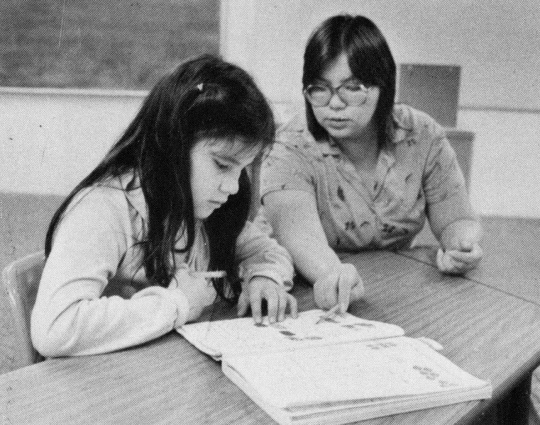
A student and teacher at the Heart of the Earth Survival School
A student and teacher at the Heart of the Earth Survival School in Minneapolis. From the 1982–1983 edition of Chimigezi Winage (the school's yearbook), page 25.
Holding Location
Articles
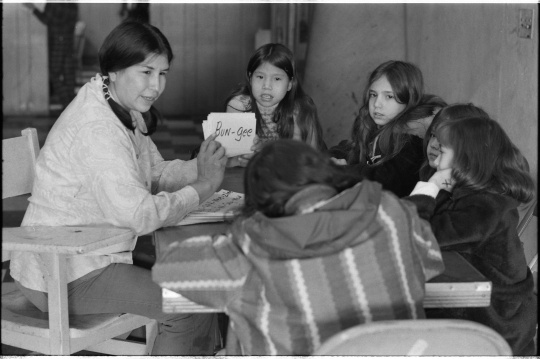
Ona Kingbird teaching Anishinaabemowin at the Heart of the Earth Survival School
Ona Kingbird teaching Anishinaabemowin (the Ojibwe language) to students at the Heart of the Earth Survival School, November 28, 1972. From the Minneapolis and St. Paul newspaper negatives collection, Minnesota Historical Society.
Holding Location
Articles
More Information
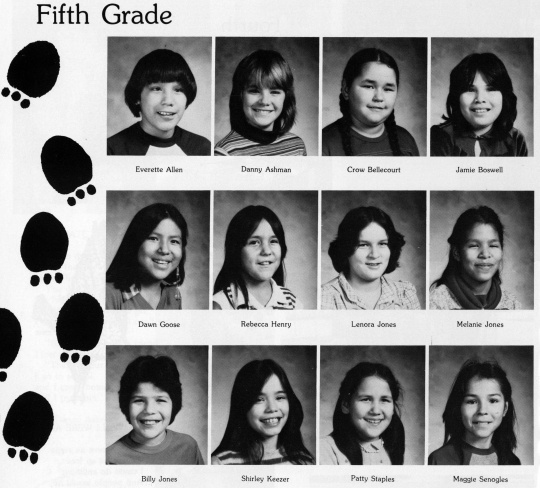
Fifth-grade students at the Heart of the Earth Survival School
Fifth-grade students at the Heart of the Earth Survival School in Minneapolis. From the 1982–1983 edition of Chimigezi Winage (the school's yearbook), page 22.
Holding Location
Articles
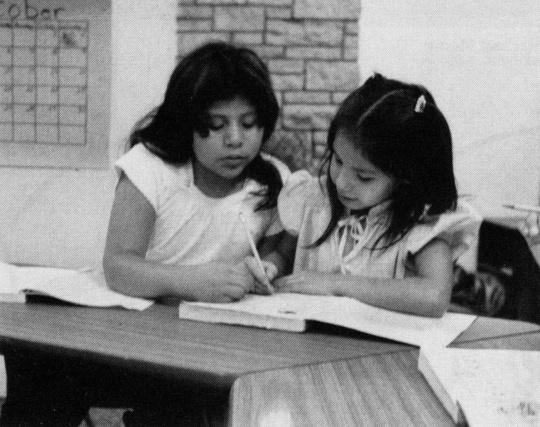
Students at the Heart of the Earth Survival School
Students at the Heart of the Earth Survival School in Minneapolis, 1983. From the 1982–1983 edition of Chimigezi Winage (the school's yearbook), page 24.
Holding Location
Articles
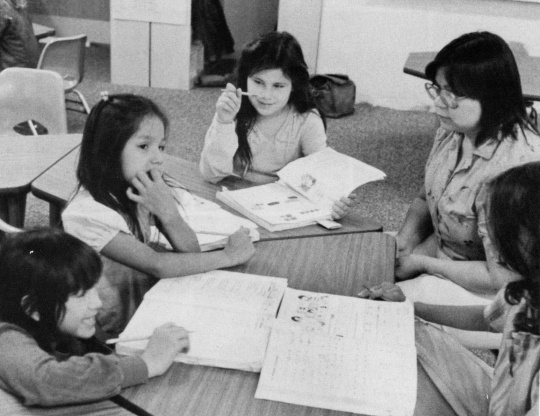
Students with their teacher at the Heart of the Earth Survival School
Second- and third-grade students with their teacher at the Heart of the Earth Survival School. From the 1982–1983 edition of Chimigezi Winage (the school's yearbook), page 25.
Holding Location
Articles
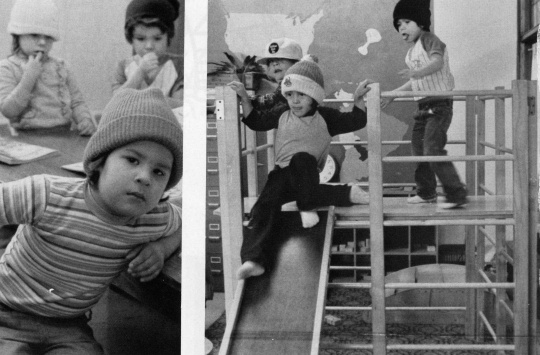
Pre-school and kindergarten students at the Heart of the Earth Survival School
Pre-school and kindergarten students on Hat Day at the Heart of the Earth Survival School in Minneapolis. From the 1982–1983 edition of Chimigezi Winage (the school's yearbook), page 32.
Holding Location
Articles
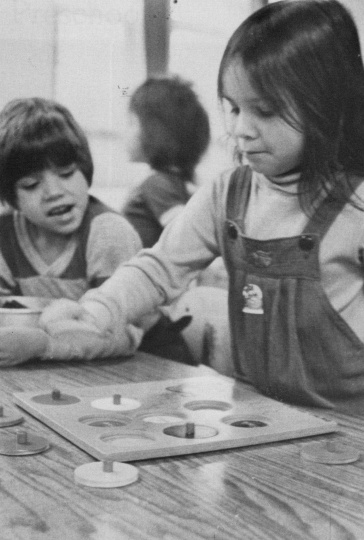
Students at the Heart of the Earth Survival School
Students at the Heart of the Earth Survival School in Minneapolis. From the 1982–1983 edition of Chimigezi Winage (the school's yearbook), page 33.
Holding Location
Articles
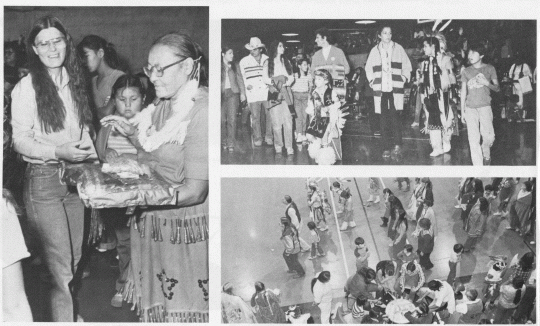
Activities at the Heart of the Earth Survival School
Activities at the Heart of the Earth Survival School in Minneapolis. From the 1982–1983 edition of Chimigezi Winage (the school's yearbook), page 36.
Holding Location
Articles
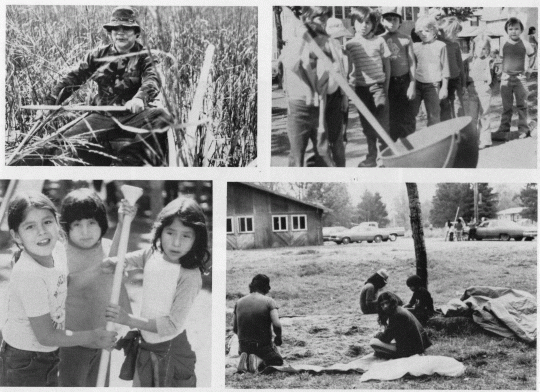
Wild-ricing educational activities organized by the Heart of the Earth Survival School
Wild-ricing educational activities organized by the Heart of the Earth Survival School. From the 1982–1983 edition of Chimigezi Winage (the school's year book), page 36.
Holding Location
Articles
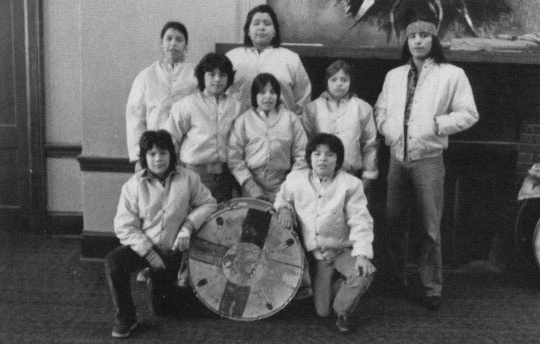
Students at the Heart of the Earth Survival School
Students with the drum used in their drum circle at the Heart of the Earth Survival School, Minneapolis. From the 1982–1983 edition of Chimigezi Winage (the school's yearbook), page 43.
Holding Location
Articles
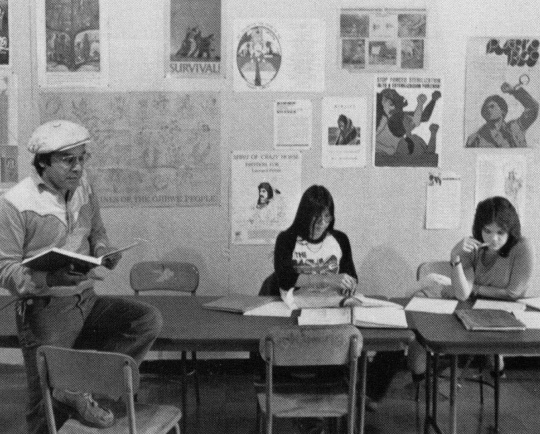
Tenth- and eleventh-grade students with a teacher at the Heart of the Earth Survival School
Tenth- and eleventh-grade students with a teacher at the Heart of the Earth Survival School in Minneapolis. From the 1982–1983 edition of Chimigezi Winage (the school's yearbook), page 11.
Holding Location
Articles
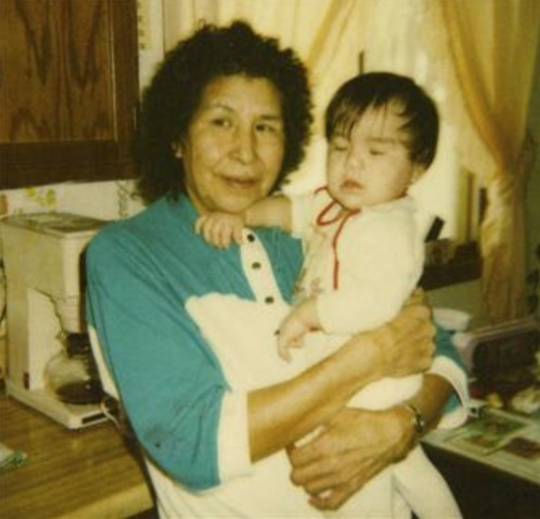
Ona Kingbird with a baby
Ojibwe elder and Heart of the Earth Survival School teacher Ona Kingbird with a baby, ca. 1980s. Used with the permission of Jon Lurie.
Holding Location
Articles

Maggie Sengoge and Porky White tapping a tree for maple sap
Maggie Sengoge and Porky White drill into a tree in order to collect maple sap as part of the Heart of the Earth Survival School. Photograph by Randy Croce, 1984.
Holding Location
More Information
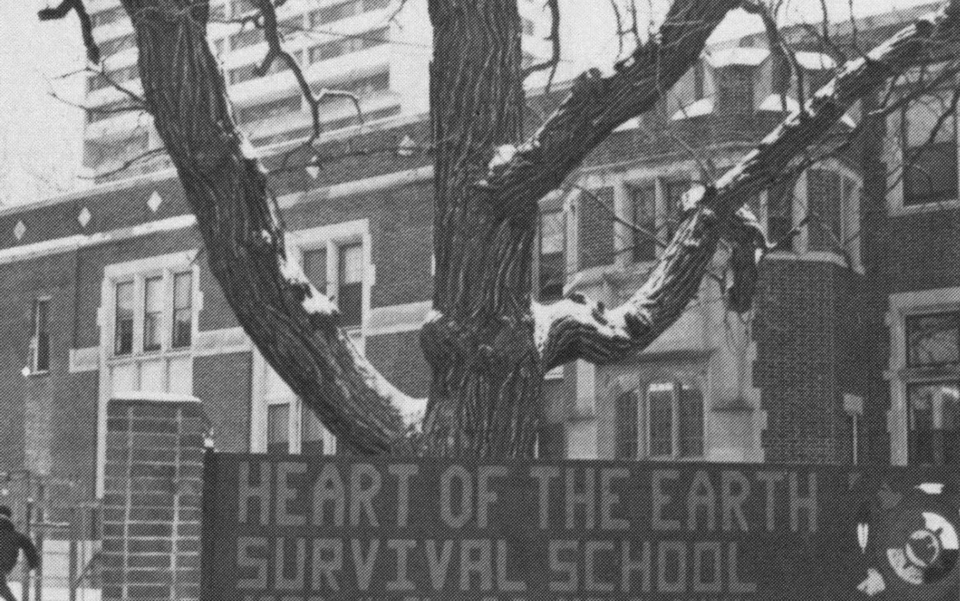
Heart of the Earth Survival School sign and building
Holding Location
Articles
Related Articles
Turning Point
In 1972, AIM hires Ona Kingbird, a young, traditional Anishinaabe woman, to infuse the survival school with Indigenous curricula. She works without pay for eighteen months, until the school locates the funding to pay her. Her devotion to the education of Native children enriches Heart of the Earth’s student body for the next thirty-five years.
Chronology
1948
1968
1969
1970
1970
1971
1972
1972
1972
1974
1975
1999
2008
Bibliography
Bellecourt, Clyde. Interview with the author, January 15, 2016.
Davis, Julie L. Survival Schools: The American Indian Movement and Community Education in the Twin Cities. Minneapolis: University of Minnesota Press, 2013.
Fardelmann, Charlotte. “Survival Schools Rescue Indian Students, Culture.” Christian Science Monitor, March 17, 1983.
https://www.csmonitor.com/1983/0317/031746.html
Furst, Randy. “Pat Bellanger, Prominent Indian Activist from Minneapolis, Dies.” Minneapolis Star Tribune, April 3, 2015.
Graves, Kathy Davis, and Elizabeth Ebbott. Indians in Minnesota. Fifth edition. Minneapolis: University of Minnesota Press, 2006.
Relerford, Patrice. “Minneapolis Cuts Ties to Heart of the Earth Charter School.” Minneapolis Star Tribune, August 13, 2008.
Tevlin, Jon. “She Taught Indians Pride; Lesson Now Is About Greed.” Minneapolis Star Tribune, June 2, 2009.
Williams, Brandt. “Charter School Embezzler Sentenced to 10-Year Term.” MPR News, August 30, 2010.
https://www.mprnews.org/story/2010/08/30/pourier-sentenced
Wishart, Diane. “Survival Schools: The American Indian Movement and Community Education in the Twin Cities.” Canadian Journal of Native Studies 34, no. 1 (2014): 206–208.
Related Resources
Primary
Kingbird, Ona. Interview with Phillips Indian Educators (PIE), August 11, 2009.
http://pieducators.com/wisdom/ona_kingbird
Secondary
Bellecourt, Clyde, as told to Jon Lurie. The Thunder Before the Storm: The Autobiography of Clyde Bellecourt. St. Paul: Minnesota Historical Society Press, 2017.
Matthiessen, Peter. In the Spirit of Crazy Horse. New York: Viking Penguin, 1983.
Salt, Lynn, and David Mueller. A Good Day to Die: Dennis Banks and the American Indian Movement. DVD. Journeyman Pictures, 2010.
Waterman Wittstock, Laura, and Dick Bancroft. We Are Still Here: A Photographic History of the American Indian Movement. St. Paul: Borealis Books, 2013.















